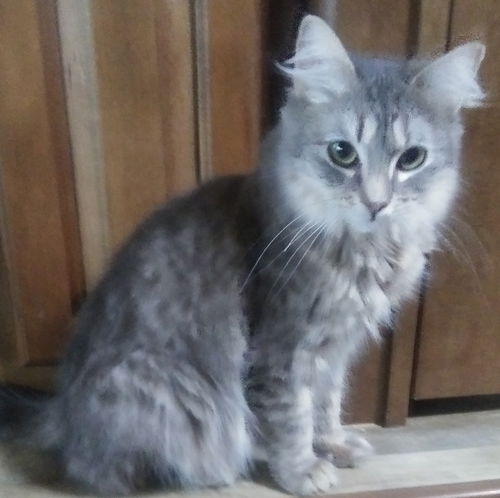2/12/2020 1:27 PM
|
Domestic Medium Hair / Mixed (medium coat) : : Female (spayed) : : Adult : : Small
Leo Feline Foundation
Cindi was born with CH (cerebellar hypoplasia). CH is caused by an underdeveloped cerebral part of the brain that regulates balance. It is caused when the pregnant momma cat is exposed to a virus. Cindi's case ranks somewhere between mild and moderate. Cindi walks with a wobbly gate. Because of balance issues she prefers petting on the ground or on a lap. Holding her with her feet off the ground scares her and she gets very wiggley. Also due to her balance being compromised , Cindi "dives" at her food so can only eat wet food. She cannot pick up nor swallow dry kibble. Otherwise, Cindi is a sweet little girl who enjoys rubbing on your leg and being petted. More about CindiIs Not Good with Dogs, Good with Cats, Is Not Good with Kids, Good with Adults, Quiet, Does not require a yard, Needs special care Special Needs: What is cerebellar hypoplasia? Cerebellar hypoplasia is a developmental condition in which the cerebellum of the brain fails to develop properly. The cerebellum is the portion of the brain that controls fine motor skills, balance and coordination. The condition is not painful or contagious. What causes it? cerebellar_hypoplasiaCerebellar hypoplasia most commonly occurs when a pregnant cat becomes infected with feline panleukopenia virus and passes the infection to her unborn kittens. The panleukopenia virus preferentially attacks rapidly dividing cells. During the perinatal period (i.e. in the last weeks of pregnancy and the first weeks after birth) the cerebellum is undergoing rapid growth and development, making it vulnerable to attack by the virus. The condition may only affect one kitten in a litter, or may involve all littermates. What are the symptoms? Since the cerebellum is responsible for purposeful movement and coordination, the symptoms of this condition may not become apparent until the kitten starts to try and stand or walk on its own. The severity of the symptoms depends on how much of the cerebellum was affected and at what stage in its development the infection occurred. The most typical symptoms are jerky or incoordinated walking, swaying from side to side when trying to walk, a goose-stepping walk called hypermetria, mild head tremors, and/or intention tremors. Intention tremors are tremors that occur when the kitten intends to make
Leo Feline Foundation is an Arizona registered 501(c)3 non-profit cat rescue
Other Pictures of Cindi (click to see larger version):
| |||||||||




